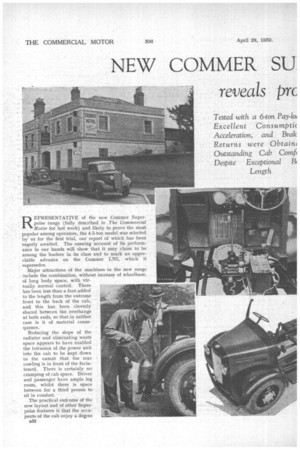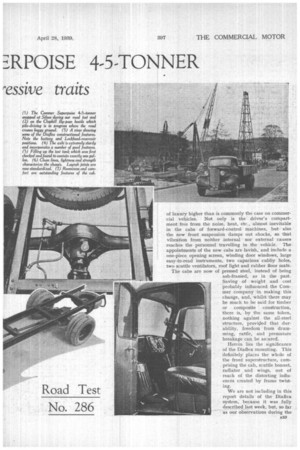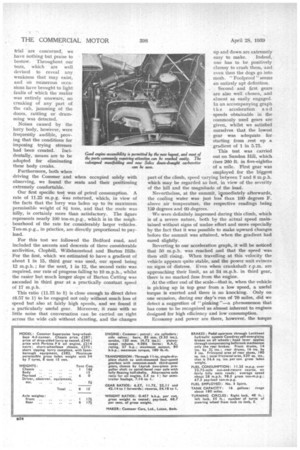NEW COMMER SU ERPOISE 4-5-TONNER
Page 38

Page 39

Page 40

Page 41

If you've noticed an error in this article please click here to report it so we can fix it.
reveals ply
Tssive traits
REPRESENTATIVE of the new Commer Superpoise range (fully described in The Commercial Motirr for last week) and likely to prove the most popular among operators, the 4-5-ton model was selected by us for the first trial, our report of which has been eagerly awaited. The ensuing account of its performance in our hands will show that it may claim to be among the leaders in its class and to mark an appreciable advance on the Commer LN5, which it supersedes.
Major attractions of the machines in the new range include the combination, without increase of wheelbase, of long body space, with virtually normal control. There has been less than a foot added to the length from the extreme front to the back of the cab, and this has been cleverly shared between the overhangs at both ends, so that in neither case is it of material consequence.
Reducing the slope of the radiator and eliminating waste space appears to have enabled the intrusion of the power unit into the cab to be kept down to the extent that the rear cowling is in front of the faciaboard. There is certainly no cramping of cab space. Driver and passenger have ample leg room, whilst there is space between for a third person to sit in comfort.
The practical outcome of the new layout and of other Superpoise features is that the occupants of the cab enjoy a degree B32 of luxury higher than is commonly the case on commer
cial vehicles. Not only is thefl driver's compartment free from the noise, heat, etc., almost inevitable in. the cabs of forward-control machines, hut also the new front suspension damps out shocks, so that vibration from neither internal nor, external causes reaches the personnel travelling in the vehicle. The appointments of the new cabs are lavish, and include a one-piece opening screen, winding door windows, large easy-to-read instruments, two capacious cubby holes, two scuttle ventilators, roof light and rubber floor mats.
The cabs are now of pressed steel, instead of being ash-framed, as in the past. Saving of weight and cost probably influenced the Cornmer company in making this change, and, -whilst there may be much to be said for timber or composite construction, there is, by the same token, nothing against the all-steel structure, provided that durability, freedom from drumming, rattle, and premature breakage can be assured.
Herein lies the significance of the Diaftex mounting. This definitely places the whole of the front superstructure, comprising the cab, scuttle bonnet, radiator and wings, out of reach of the distorting influences created by frame twisting.
We are not including in this report details of the Diaflex system, because it was fully described last week, but, so far as our observations during the trial are concerned, we have nothing but praise to • bestow. Throughout our tests, which are well devised to reveal any weakness that may exist, and on numerous occasions have brought to light faults of which the maker was entirely unaware, no creaking of any part of the cab, jamming of the doors, rattling or drumming was detected.
Noises caused by the lofty body, hoWever, were frequently audible, proving that the conditions for imposing trying stresses had been created. Incidentally, means are to be adopted for eliminating these body creaks.
Furthermore, both when driving the Comrner and when occupied solely with observing, we found the seats and their positioning extremely comfortable.
Our first specific test was of petrol consumption. A
rate of 11.25 m.p.g. as returned, which in view of the facts that the lorry was laden up to its maximum permissible weight of n tons, and that the route was hilly, is certainly more than satisfactory. The figure represents nearly 100 ton-m.p.g., which is in the neighbourhood of the rate for considerably larger vehicles. Ton-m.p.g., in practice, are directly proportional to payload.
For this test we followed the Bedford road, and included the ascents and descents of three considerable Clophill, Willshanastead and Barton Hills.
For the first, which we estimated to have a gradient of about 1 in 15, third gear was used, our speed being 12 m.p.h.; for the next, 1 in 12, the second ratio was required, our rate of progress falling to 10 m.p.h., whilst the easier but much longer slope of Barton Cutting was ascended in third gear at a practically constant speed of 17 m.p.h.
This ratio (11.75 to 1) is close enough to direct drive
(6.57 to 1). to be engaged not only without much loss of speed but also at fairly high speeds, and we found it a particularly useful gear. Moreover, it rims with so little noise that conversation can be carried on right across the wide cab without shouting, and the changes
up and down are extremely easy to make. Indeed, one has to be positively clumsy to crash them, and even then the dogs go into mesh. " Foolproof" seems an entirely apt definition.
Second and first gears are also well chosen, and almost as easily engaged. In an accompanying graph the acceleration a ii d speeds obtainable in the commonly used gears are given, whilst we satisfied ourselves that the lowest gear was adequate for starting from rest up a gradient of 1 in 5.75.
This test was carried out on Sundon Hill, which rises 260 ft. in five-eighths of a mile. First gear was employed for the biggest part of the climb, speed varying between 7 and 8 m.p.h. which may be regarded as fast, in view of the severity of the hill and the magnitude of the load.
Nevertheless, at the summit, hiannediately afterwards, the cooling water was just less than 100 degrees F. above air temperature, the respective readings being 159 degrees and 60 degrees.
We were definitely impressed during this climb, which is of a severe nature, both by the actual speed maintained without signs of undue effort and more especially by the fact that it was possible to make upward changes before the summit was attained, when the gradient had eased slightly.
Reverting to our acceleration graph, it will be noticed that 50 m.p.h. was reached and that the speed was then still rising. When travelling at this velocity the vehicle appears quite stable, and the power unit evinces no signs of distress. Even when crankshaft r.p.m. are approaching their limit, as at 34 m.p.h. in third gear, there is no marked fuss from the engine.
At the other end of the scale—that is, when the vehicle is picking up in top gear from a low speed, a useful torque is exerted and there is no knocking. Only on one occasion, during our day's run of 70 miles, did we detect a suggestion of "pinking "—a phenomenon that has come to be recognized as almost inherent to engines designed for high efficiency and low consumption. Economy and power are there, however, the torque being actually about 5 per cent, higher than formerly. Bearing this in mind, it is interesting to note that the acceleration is not far short of that obtained by us with an earlier model, although the load on the recent occasion was about 14 per cent. greater.
T h e power-toweight ratio on our test of the Superpoise 4-5-tonner was 0.457 b.h.p. per cwt., whilst in the case of the LN5 the figure was 0.513, the engine output in both cases being 80 b.h.p., but the old and new torque figures 176 and 180 lb.-ft. respectively. T h Apart from measured observations, the vehicle, in ordinary running, is lively and responsive, and it certainly possesses the characteristic generally defined as having a good top-gear performance.
• Hydraulic brakes are a new feature, mechanical actuation having been the former Commer practice. The improvement in efficiency is pronounced. As will be seen from our graph, the stopping distance from 30 m.p.h., using the foot brake alone, is only 52 ft. That is equivalent to 58 per cent. efficiency and is classed by Ferodo, Ltd., as '! very pod "• for any type of vehicle. Last July we recorded with the LN5 model a stopping distance of 65 ft. The corresponding respective stopping times were about 21 and 3i seconds.
In order to achieve quick retardation it is necessary,• in designing the layout, to take advantage of weight transference by apportioning an adequate share of the braking to the front wheels. The Comrner engineers
have appreciated this fact, hence the good results. Judging, however, by the tyre marks, we are inclined towards the view that perhaps the scheme has been very slightly overdone. We suggest that possibly still better braking might accrue from a small adjustment, in the direction of the distribution of the brake applying force. It may be that the employment on the new chassis of somewhat Softer front springs than formerly has a bearing on this.
These springs result in smoother running and an outstanding feature of this new Superpoise model is the manner. in which it negotiates bad road surfaces with the minimum of disturbance to cab .occupants or load.
Not only the springs but also the steering arrangements have been altered. The outcome is better roadholding and lighter steering than formerly. In view of the big load carried, the effort required to pull the wheels over when rounding a sharp bend is certainly . moderate.
Final comments, of a general character, that seem to be called for are in connection with the rating, capacity and unladen weight of this new COmmer. With 32 by 6 tyres, its rating is 4-5 tons, but with 34 by 7 equipment 6 tons may be carried, as on our trial... One would, therefore, be justified in anticipating that, when laden to capacity, there would be apparent a sluggishness of performance. This did not prove to be the case. The unladen weight with large lorry body is just under 50 cwt., but it is of note that no less than 13 cwt. is available for bodywork. Thus the need for cutting body weight to the extent of fragility is non-existent. A close investigation of chassis details reveals that, in spite of the low weight, the whole is actually stronger than formerly. Indeed, ample evidence of this can be afforded without the need for careful scrutiny.
Some rnay comment that " Superpoise " is no more than a magniloquent designation, but, whether it be so or not, there are concrete attractions to support the choice of a high-sounding name and to commend the new range to operators whose livelihood depends on vehicles which will give efficient performance, reliable service and long mileages.
Competition in the maximum-load 30 m.p.h. class is keener, probably, than in any other, but the reception that has already been accorded to this new Comrner—indeed to the .whole new range—corrobates our view that it will achieve widespread success.












































































